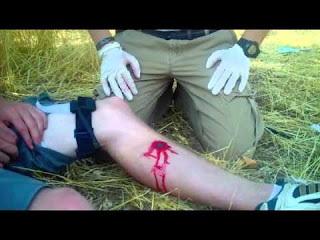Tourniquet's: NO DON'T PLACE IT THERE!
Let's go over a very common scenario that many make mistakes on, even myself was prone to this mistake. How to put on a tourniquet:
Scenario: MVC with a pole, an ejection patient with a head bleed. The patient is refusing care, does not want to be seen, but you see a lot of hemorrhaging. The patient is arguing with you. The patient finally lets you assess him and the bleeding is so profuse it won't stop with direct pressure, quick clot, or anything. What are we going to do!?!?
If you are like me, I know your first thought:
But, contrary to popular thought, you are not suppose to use tourniquet's on peoples necks! You see, as I found out the hard way, a tourniquet to someone's neck will cut off blood supply (good! it stops the bleeding), but it will also cut off the oxygen needed to perfuse the brain (bad! it will kill a patient, rest in peace little Jimmy, sigh).
Here are some examples of what not to do:
Here is another example of what not to do:
So now that we know that tourniquets can not be used on the neck (won't make that mistake again), lets focus on where they can be used:
Extremities!
Let's look at a good tourniquet placement:
Tourniquets need to be proximal to cut off blood flow to the extremity, this way the patient won't bleed out.
When in doubt, don't place a tourniquet around the patients neck, that is bad, but a tourniquet for a bleeding that won't stop with direct pressure, gauze and quick clot, name, date, and time the tourniquet on the extremity. Be sure not to never take off the tourniquet until you
Scenario: MVC with a pole, an ejection patient with a head bleed. The patient is refusing care, does not want to be seen, but you see a lot of hemorrhaging. The patient is arguing with you. The patient finally lets you assess him and the bleeding is so profuse it won't stop with direct pressure, quick clot, or anything. What are we going to do!?!?
If you are like me, I know your first thought:
But, contrary to popular thought, you are not suppose to use tourniquet's on peoples necks! You see, as I found out the hard way, a tourniquet to someone's neck will cut off blood supply (good! it stops the bleeding), but it will also cut off the oxygen needed to perfuse the brain (bad! it will kill a patient, rest in peace little Jimmy, sigh).
Here are some examples of what not to do:
 |
| You see, a tourniquet around the neck has made this patient go pale, due to restricted blood flow, unfortunately there is no oxygen being delivered as well. This a no no! |
Here is another example of what not to do:
Extremities!
Let's look at a good tourniquet placement:
 |
| Notice the tourniquet is placed proximal to the heart than the wound. The wound is distal to the tourniquet, while the tourniquet is proximal to the wound! |
When in doubt, don't place a tourniquet around the patients neck, that is bad, but a tourniquet for a bleeding that won't stop with direct pressure, gauze and quick clot, name, date, and time the tourniquet on the extremity. Be sure not to never take off the tourniquet until you





Comments
Post a Comment